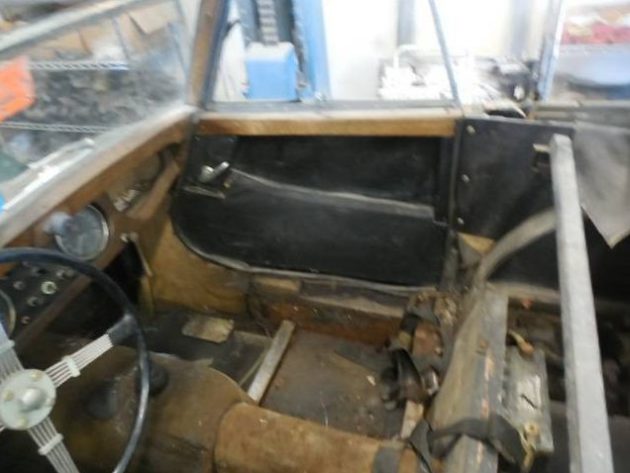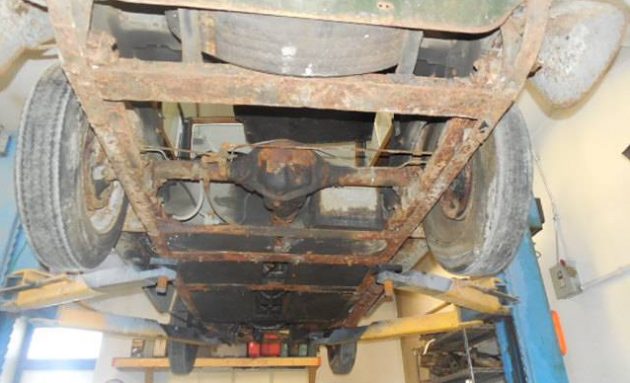The Plus 4 was introduced in 1950 and built until 1969 and revived in 2014. Many describe the Morgan as a true British sports car. Perhaps the TV show “Top Gear” described the Plus 4 Experience best when they described it as, “as fine a British institution as cold showers and caning”. For those of you unfamiliar with the term, caning here does not refer to repairing chair seat bottoms but instead refers to beating upon the offenders bottom or other parts with a cane. This Plus 4 is offered for sale on Hemmings for $11,900. It’s been stored since 1968 when the Triumph engine suffered a burned valve.
There’s not much left of the interior, although most of the dash is there. Hopefully the seats are included.
One can only hope that the rust is only surface rust. Either this Morgan wasn’t stored very well or it was in sad condition before it was put away.
Hopefully, given the lack of visible rust and the clean oil, perhaps the TR 4 engine isn’t stuck.
There are a lot of unknowns to be investigated before deciding if this Plus 4 would be a worthwhile project. The frame needs to be more metal than holes and the wooden body frame must be in solid. With reasonable drivers selling for under $20,000 there’s not much room before one would be upside down. Hopefully someone will make this Morgan a labor of love and not a parts car.






You would think that a Clarkson engineer could fix a burned valve. The car didn’t go far from campus. I lapped a burned valve on a $25 ’56 Plymouth Savoy in an afternoon for the price of the head gasket and a tube of gasket cement about the time the Morgan died. I would have rather been working on the Morgan!
What a great juxtaposition….beautiful body work on a ladder frame by an apprentice welder. Swap the frame for a 12′ aluminum extension ladder. None the less a striking car!
Fresh oil in the cylinders ?
It’s stuck 😢
My prayers for the future owner 🙏🏻🙏🏻🙏🏻🙏🏻🙏🏻🙏🏻
This story has more holes in it than a back road in Wisconsin. That underside shot, who says British cars don’t leak oil? It’s leaking from every oil source, and by the looks of it, for a while. Somebody drove this car hard, and left it out in the rain with the top down on many occasions. These were/are quality cars, I’ve never known a British car to suffer a burned valve, ( my AMC motors, different story) they are top notch engines and there’s no way it would look like this with only 5 years use, sorry. There’s no doubt how cool these cars are, I just don’t know about this one. Lot of work here, and that’s only what we can see.
Howard — It’s my belief that valves in the UK rarely burned because of the poor grades of fuel at the time, this resulted in buildups of carbon clumps on the heads & valves. A common engine service was the removal of the cylinder head and “decoking” [removing the carbon deposits]. For 1950s & earlier UK driven cars, this was often a yearly event! Most of the cars in the UK got the decoking service before the valves had a chance to burn!
I’ve had a couple of Mogs, and worked on quite a few. These cars always had slightly leaking seals on the drive line. I’ve always wondered if this was a planned method of keeping the drive line components from rusting badly!
The clean oil isn’t supposed to be on top of the pistons. Looks like a failed attempt at getting the little engine free again.
I did many many head gasket and an occasional valve job on TR3’s and TR4’s. Valve jobs were usually the result of someone mis adjusting the valve clearance.
The condition of the engine is the least of my concerns. This is from the North and was poorly stored. I would want to closely inspect for corrosion and wood rot. These are constructed just like a MG TC or TD, with an ash body frame with tin tacked to it. Sure is rough for being on the road for only 5 years.
The Triumph engines were a “wet sleeve” design as you can readily see here. Like an 18 wheelers diesel engine, you remove the pistons AND the cylinder liners. They seal to the block at the bottom and coolant circulates around the sleeves. I think you’d have to disassemble this engine for that reason anyhow. An overhaul kit can include new pistons and liners. :-) Terry J
Looks to me like the gas tank is missing, having spent many hours under one of these
Mark —
This isn’t the typical Morgan roadster, it’s a drophead coupe. The fuel tank is located behind the upper section of the spare tire. The lower outer corners of the tank can be seen in the photo of the chassis.
5 Years?…… HAHAHAHAHAHA I think not.
Five years of age was ancient in the nineteen sixties.
Is it possible that there are 2000 day years in this cars’ location – 5 ‘normal’ years? I don’t think so
Dog years
I certainly hope the next person to try to turn the engine over either puts the head back on with a couple of head bolt nuts or has a cylinder retainer, even a homemade one, to keep the cylinder liners from popping out of place and mangling the figure-of-eight joints that mate them to the bottom of the block. The missing studs suggest hat this may have already happened. Looking at the condition of the rest of the car (no mention of mileage on the clock) I would think that a teardown to check main bearings, replace the rear main and other seals would be in order. These engines were designed to be easily rebuilt by blokes in their home garage with minimal tools, which is why Harry Ferguson adapted them to his tractors so farmers could keep them running forever. Took me about two days of work, aside from time in the machine shop, for me to assemble my TR3 engine in 1985. It then sat, with the occasional rotation by the starter twice a year, for the next 22 years. Took less than 5 minutes to get it running once the bodywork was done, and it has had 10,000 miles of wonderful driving in the last nine years. If the internal bodywork is acceptable, this would be a rewarding project for someone.